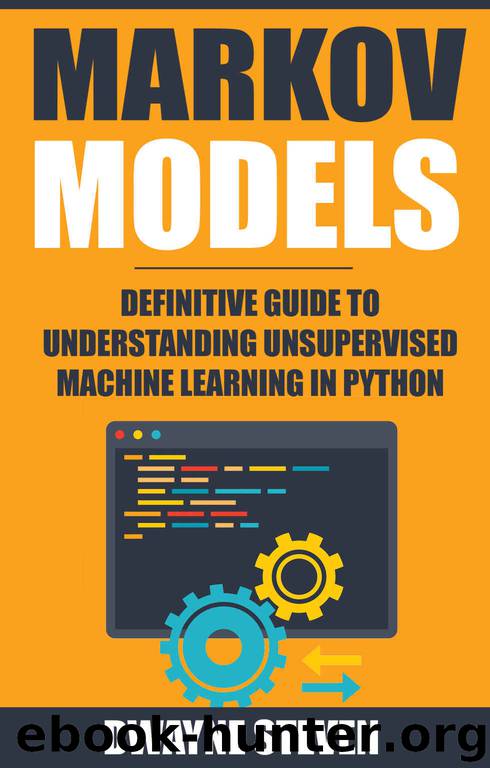Markov Models: Definitive Guide to Understanding Unsupervised Machine Learning In Python by Dwayne Steven

Author:Dwayne Steven
Language: eng
Format: azw3
Published: 2017-08-14T07:00:00+00:00
Machine Learning Type #1: Supervised Learning
Machine learning that is supervised is the most hands-on type of machine learning. This type of machine learning requires the user to input information about patterns that the computer will expect to see. For example, if you are training a computer to recognize cat faces, you would input information on cat faces and examples of cat faces, and the machine would learn from your examples how to determine whether an image contains a cat face.
This type of machine learning requires that you know about the knowledge that you are seeking. That is, you need to have examples of what you are looking for in order to perform knowledge discovery and data mining using supervised machine learning.
Supervised machine learning sounds like it might be more work than it is worth in some cases, and indeed, needing to have examples of what you are trying to predict might be asking too much in some cases, but this type of machine learning can be useful. Let us take a look how supervised learning can help in order to contrast with how unsupervised learning contributes to our knowledge discovery and data mining.
1) Supervised machine learning techniques can analyze decision trees. Decision trees are helpful in classification and regression problems. In classification problems, supervised machine learning can predict to which class a piece of data belongs based on the “leaves” that are attached to it. The “leaves” are the characteristics of the data point attached in a leaf-like fashion in a tree-like model. Regression tree analysis predicts a real number, such as the length of stay for a patient in the hospital or the price of a house in the housing market.
2) Supervised machine learning techniques can analyze random decision forests. Random decision forests are exactly what they sound like – a group of decision trees. The same classification and regression analyses can be made using supervised machine learning with random decision forests. Classification analysis determines the mode, or the value or values seen most often in the data tree, and regression calculates the mean, or the average value for any given tree.
3) Supervised machine learning is also useful in evaluating and analyzing k-NN algorithms, which stands for k-nearest neighbor algorithms. This is the simplest machine learning algorithm and therefore works well with supervised machine learning. When the k-NN algorithm in analyzed in terms of classification, the results show class membership, that is, the belonging of data points to various classes. If the k-NN algorithm is analyzed regressively, the analysis takes into account the value of the nearest neighbors and thereby calculates the “property value” of the data point in question.
Download
This site does not store any files on its server. We only index and link to content provided by other sites. Please contact the content providers to delete copyright contents if any and email us, we'll remove relevant links or contents immediately.
Hello! Python by Anthony Briggs(10121)
The Mikado Method by Ola Ellnestam Daniel Brolund(10013)
OCA Java SE 8 Programmer I Certification Guide by Mala Gupta(9980)
Algorithms of the Intelligent Web by Haralambos Marmanis;Dmitry Babenko(8522)
Sass and Compass in Action by Wynn Netherland Nathan Weizenbaum Chris Eppstein Brandon Mathis(7915)
Grails in Action by Glen Smith Peter Ledbrook(7882)
Test-Driven iOS Development with Swift 4 by Dominik Hauser(7853)
The Well-Grounded Java Developer by Benjamin J. Evans Martijn Verburg(7770)
Windows APT Warfare by Sheng-Hao Ma(7484)
Layered Design for Ruby on Rails Applications by Vladimir Dementyev(7235)
Blueprints Visual Scripting for Unreal Engine 5 - Third Edition by Marcos Romero & Brenden Sewell(7122)
Secrets of the JavaScript Ninja by John Resig Bear Bibeault(6641)
Kotlin in Action by Dmitry Jemerov(5299)
Hands-On Full-Stack Web Development with GraphQL and React by Sebastian Grebe(4383)
Solidity Programming Essentials by Ritesh Modi(4380)
WordPress Plugin Development Cookbook by Yannick Lefebvre(4193)
Functional Programming in JavaScript by Mantyla Dan(4124)
Unity 3D Game Development by Anthony Davis & Travis Baptiste & Russell Craig & Ryan Stunkel(4107)
The Ultimate iOS Interview Playbook by Avi Tsadok(4076)
